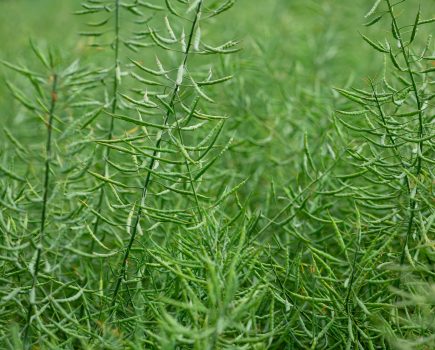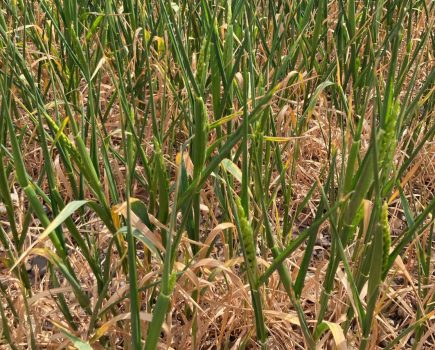The latest season on record at the Hutchinsons northern maize trials has reinforced the importance of tailoring variety choice to planned drilling date next spring.
The trials, hosted by the Fisher family at Smalmstown Farm near Carlisle, featured 30 new and established varieties in 2024, some grown in the open and others under film, providing a unique comparison of the agronomic traits and yield potential of each one in the challenging growing conditions of northwestern England.
Poor weather characterised much of the 2024 season, which saw the latest-ever drilling of maize trials on 8 May, and also the latest harvest in mid-October, according to Hutchinsons agronomist, Jim Clark.
“Generally, that reflects what we saw in the field this season too, and in such a challenging year, anything that helped crops establish quickly really stood out in terms of the results.”
Variety differences shine through
Differences in varietal traits, notably speed of establishment and maturity, were particularly evident this year, Mr Clark says.
“In many cases, there was a 10-week drilling window for maize from April to the first week of June, which really proved that growers have to pick the best varieties for when they want to drill. There are some good varieties available, we just have to fine-tune choices more.”
He acknowledges that can be difficult given the vagaries of UK weather, but where growers are likely to drill late, it is worth selecting varieties better suited to that timing, and vice versa.
“Growers have often tried to push varieties to the limit of what they can do, but maybe this year was a wake-up call to be a bit more realistic, in the North at least.”
Mr Clark cites the example of P7034, which has remained a big seller for many farmers in the area due to its high rumen-degradable starch content, and is likely to prove popular again next year. In contrast, P7326 has dropped off the radar for some after several years on the market, but is one of the earliest maturing varieties when grown under film, with an earlier FAO maturity rating than P7034, and is potentially better suited to late-sowing situations.
“If you are forced to drill a week or two later, or you’re on heavy land and know you’ll want to get the crop off early, then it does pay to go for an earlier maturing variety such as P7326.”
Looking at other varieties in the 2024 trials, Mr Clark says the Bayer varieties (DKC3204 and DKC3218) stood out for their early vigour, and have proven popular with farmers visiting the trials. Experience with the varieties in Hutchinsons trials also suggests they are slightly earlier maturing than their official FAO ratings indicate.
“For instance, DKC3204 has a rating of 210, but from what we’ve seen in the field, while it is slightly later, we think it’s actually closer to P7034, which is rated nearer 180-190.”
Open crops
Commenting on the performance of open ground crops in 2024, Mr Clark admits those in the trials suffered significant damage by rooks and seagulls during establishment, making it hard to read too much into yield results. However, previous trials and experience on other farms in the area shows Prospect remains a good performer when grown in the open.
“It’s not mega early, more of a 170 than a 150 or 160, but it’s quite vigorous out of the ground and we can normally get crops to maturity in good time. A lot of growers like Prospect purely because if the weather’s ok, it’s just a bit bigger than the ultra-early varieties, and might push 16-18 t/acre, which is at the limit of what we can do in the open.”
But Mr Clark points out that while Prospect does well sown early in the open, experience shows the variety can struggle when grown under film.
“We think the cut-off for sowing crops in the open is around 10-15 May up here. If you’re drilling after that, you should go back to putting maize under film to help crops catch up. Prospect isn’t best suited to that situation [under film], so you are better going with a variety like P7179 or P7326.”
Placement fertiliser benefit
The Carlisle maize trials once again highlighted the clear benefits from using placement phosphorus fertilisers to help maize establish strongly, particularly in open ground crops, but also under film.
Placing a smaller quantity of microgranular fertiliser with seed at drilling offers cost savings over traditional DAP applications, and improved nutrient use efficiency, which benefits rooting, establishment, and yield potential, Mr Clark says.
This was evident in the trials, where DKC3204 sown with Primary-P, for example, went on to produce a dry matter yield of 1.22 t/ha more than the same variety without placement fertiliser. At a milk price of 45p/litre, this extra DM yield was worth an additional £887.20/ha (see table). Another product, Crystal Green, also gave a DM yield benefit, worth more than £700/ha in additional milk value.
“A lot of local contractors are now getting on board with placement fertiliser, and many say it is also easier to use than DAP,” notes Mr Clark.
[Table] Benefits of placement fertiliser
| DKC3204 no placement fert | DKC3204 with PP | DKC3204 with CG | |
| Freshweight yield t/ha | 37.40 | 39.92 | 39.01 |
| DM yield (t/ha) | 12.68 | 13.09 | 12.80 |
| DM yield benefit (t/ha) | – | 1.22 | 0.12 |
| Milk value (£/ha) | 10,118.09 | 11,005.29 | 10,863.81 |
| Milk value benefit (£/ha) | – | 887.20 | 745.72 |
Undersowing
Undersowing maize with grass or crimson clover mixes is increasingly popular among maize growers, offering several benefits to soil health and the wider business, including:
- Protects soil from erosion and nutrient leaching
- Soil conditioning
- Potentially makes fields easier to travel at harvest
- Allows a ready-made sward to be grazed soon after maize is cut
- Broadcasting grass into maize can be an effective and low-cost establishment method
- Nitrogen benefit in following crops from clover
Mr Clark says last year’s undersowing trials at Carlisle were a great success, with different sowing rates and establishment methods tested.
Using disc drills to sow grass into maize ground worked particularly well, and was a “step-up” in establishment. However, because grass must be sown before maize gets too large (e.g. 6-8 leaf stage) to avoid crop damage when drilling with an inter-row grass drill, the team has found the vigorous Westerwold mix can grow too big.
“If we’re going to use mechanical drills to sow grass in maize early, we’ll probably have to look for a slower-maturing grass.
“In contrast, where the Westerwold mix is broadcast into standing maize as late as you can travel through with a fertiliser spinner, we need that vigour because the grass is going in so much later and has to reach a certain size before maize shades it out.”
Mr Clark also points out that when drilling grass into maize, growers have to recognise any risks from pre-emergence grassweed herbicides. “You want as big a gap between herbicide application and sowing the grass as you can get. That window wasn’t massive this year, because once the maize gets too large, you can’t use a mechanical drill. It’s a tricky balance.”
Looking at seed rates for undersowing, he says 7.5-10 kg/ha (3-4 kg/acre) of Westerwold did provide reasonable cover, but for farmers wanting to graze land with sheep once maize is taken off, rates should be nearer 17-20 kg/ha (7-8 kg/acre).
Mr Clark notes a big uptake in farmers sowing grass into maize stubbles after harvest for the SFI, which has generally established well, but will not be suitable for grazing until into the New Year, whereas grass drilled or broadcast into maize is far more advanced.
Next season, he plans to continue refining undersowing techniques, potentially looking into using grass mixes with different maturities. He is also considering trialling companion cropping maize with a certain variety of bean that is safe for cows to eat.

For more like this, sign up for the FREE South East Farmer e-newsletter here and receive all the latest farming news, reviews and insight straight to your inbox.







